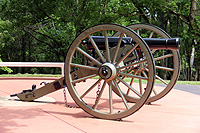The 111th meeting
 Clarksville, TN – The next meeting of the Clarksville (TN) Civil War Roundtable will be on Wednesday, June 19th, 2013 at the Bone & Joint Center, 980 Professional Park Drive, right across the street from Gateway Hospital. This is just off Dunlop Lane and Holiday Drive and only a few minutes east of Governor’s Square mall.
Clarksville, TN – The next meeting of the Clarksville (TN) Civil War Roundtable will be on Wednesday, June 19th, 2013 at the Bone & Joint Center, 980 Professional Park Drive, right across the street from Gateway Hospital. This is just off Dunlop Lane and Holiday Drive and only a few minutes east of Governor’s Square mall.
The meeting begins at 7:00pm and is always open to the public. Members please bring a friend or two – new recruits are always welcomed.
Topic: “The Tullahoma Campaign And its Effects on the War, June-July 1863”

The attack was repulsed and the Mississippi River would remain in Union hands especially after the fall of Port Hudson a few days later. The other campaign, often omitted, is the Tullahoma Campaign, the masterpiece of maneuver by Union General William S. Rosecrans. We are coming upon the 150th Anniversary of that campaign.
Rosecrans and his chief of cavalry, David Stanley, planned to feint against CS General Braxton Bragg’s left flank with the cavalry and one corps while making their main thrust against Bragg’s right. Thomas Crittenden’s Corps was the coup de main, heading east from Murfreesboro before turning south on the direct road to Manchester.
George Thomas’ Corps was to his right aiming for the Confederate defenses at Hoover’s Gap, the road also going to Manchster. To his right was Alexander McCook’s Corps who was to feint against Liberty Gap and fix Patrick Cleburne’s Division in place.
Next came the cavalry corps of Stanley and Gordon Granger’s Reserve Corps who were to demonstrate against Guy’s Gap fixing Polk’s Corps in place at Shelbyville. The Manchester objective was part of the larger scope of the capture of the bridges at Allisonia/Estill Springs before Bragg could react.
If Rosecrans plan worked he would force Bragg to fight on ground of Rosecrans’ choosing to reopen his line of supply to Chattanooga trapping the Army of Tennessee and hopefully destroying it. But the weather had other plans; it would rain almost every day of the campaign from June 23rd-July 4th, 1863.
In the end, Bragg would escape but Rosecrans would gain his fifth victory of the war giving him the best combat record of any Union army commander to that point. Middle Tennessee was overrun and the Confederates pushed to Chattanooga. Rosecrans’ brilliant campaign was even overlooked that time by his own War Department, to which Rosecrans would respond that it would be a shame to overlook the exploits of the Army of the Cumberland because, “they were not written in letters of blood.”
Indeed, with less than 2000 casualties, Rosecrans gained a state; had the campaign resembled Gettysburg in body counts everyone who studies the war today would know about this campaign.We are very lucky to have Chris Kolakowski, author of the most recent book on the campaign, coming to speak to us this month. Christopher L. Kolakowski received his BA in History and Mass Communications from Emory & Henry College, and his MA in Public History from the State University of New York at Albany.
Chris has spent his career interpreting and preserving American military history with the National Park Service, New York State government, the Rensselaer County (NY) Historical Society, the Civil War Preservation Trust, and the Army Reserve. From 2005-2008 Chris was Executive Director of the Perryville Enhancement Projec which added 152 acres of critical battlefield land and increased Perryville’s national profile. He has written and spoken on the Civil War, American Revolution, Napoleonic Wars, and both World Wars.
He is the author of two books by the History Press, The Civil War at Perryville: Battling For the Bluegrass and The Stones River & Tullahoma Campaigns: This Army Does Not Retreat. Chris currently serves as Director of the General George Patton Museum of Leadership in Fort Knox, KY.
In 2013 the U.S. Army will publish his volume on the 1862 Virginia Campaigns as part of its sesquicentennial series on the Civil War. He is also working on a study of the Philippine Campaign of 1941-42, scheduled for release in 2016.


